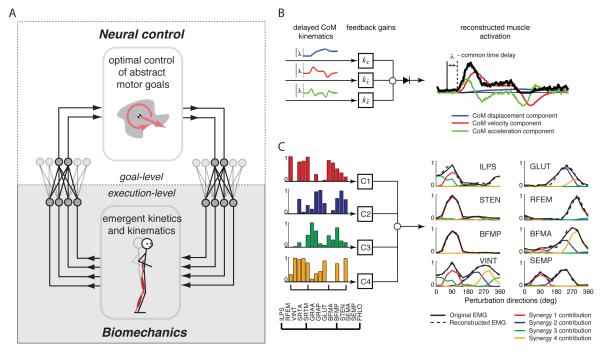Figure 1.
A) Hierarchical neuromechanical framework for understanding muscle coordination. The low-dimensional structure of neuromotor outputs reflects the desired control of task-level goals. A dimensional reduction occurs in the multisensory integration mappings that use multiple afferent signals to estimate task-variables. B) In perturbed balance control, temporal patterns of muscle activity are governed by delayed feedback of CoM kinematic variables. Thus the entire timecourse of muscle activity can be compactly described using three feedback gain variables and a delay term. Each component of CoM motion is multiplied by a feedback gain at a common time delay and linearly added to produce a reconstructed muscle activation pattern or muscle synergy recruitment pattern. C) These temporal patterns reflecting task-level variables must then be mapped to a spatial distribution of muscles in order to generate execution-level motor commands to muscles. Muscle synergies allow task-level neural commands to be translated into execution-level muscle activation patterns. Spatially-fixed muscle synergies with variable recruitment patterns explain a wide variety of individual muscle activation patterns. Shown here are muscle synergies from cat responses to translation perturbations in 12 directions. Recorded muscles include Iliopsoas (ILPS), Rectus femoris (RFEM), Vastus intermedius (VINT), Anterior sartorius (SRTA), Medial sartorius (SRTM), Anterior gracilis (GRAA), Posterior gracilis (GRAP), Gluteus medius (GLUT), Anterior biceps femoris (BFMA), Posterior biceps femoris (BFMP), Semitendinosus (STEN), Anterior semimembranosus (SEMA), Posterior semimembranosus (SEMP), and Flexor hallucis longus (FHLO). The activation of an individual muscle results from adding the activation due to each muscle synergy. For 90° perturbations, the activation of SEMP is strictly co-activated with BFMP and STEN due to recruitment of the red muscle synergy. In contrast, for 270° activation of the same SEMP muscle is strictly coactivated with GLUT due to recruitment of the blue muscle synergy. Together our frameworks allow us to functionally decompose the multiple influences shaping the spatiotemporal patterns of muscle activation for task-level motor control.

